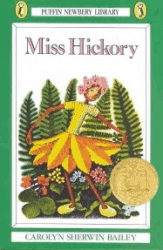
Chapter Two Synopsis of Discussion

Week of July 15, 2007
Chapter 2 – Moon Before Snowfall
In Chapter 2 Miss Hickory gathers berries, and brings them home to
prepare for winter, but she finds T. Willard Brown at her house. After he confirms
that the Family has indeed already left for Boston, Miss Hickory leaves her
basket and hurries off to see for herself. Sad to say, she finds the house empty!
__________________________
This is a very emotional chapter. We certainly can contrast Miss Hickory's
practical lifestyle with Hitty's passive lifestyle. Miss Hickory knows she needs
food for winter and goes to get it, while Hitty doesn't even eat--or feel the
need. You can just feel how upset she is all through this chapter, trying to
ignore what she knows--that the family is gone and winter is coming--and then
Mr. T. Willard-Brown telling her that Squirrel has moved into her house and
eaten what she had managed to set aside for winter. When she refused his offer
of the barn for a winter home, she seemed more in denial than deliberately refusing
it for other reasons.
__________________________
I agree. There is quite a bit of tension in this chapter and I really
wanted Miss Hickory to move into the barn where I figured she could stay warm
and dry. She must have a strong sense of independence and self sufficiency to
start all over preparing for winter.
__________________________
And stubbornness! And I really think she just didn't want to believe
the bad news, and was reeling from it, and reacting poorly.
__________________________
Chapter 2 finds Miss Hickory in a state of denial about losing her beloved home. She attends to daily duties and heads for the forest for some berries to finish her canning. She reminds herself that Crow “always has something to say and likes to hear himself say it.”
I have to say that like Miss Hickory I have been “in denial” at times in my life and have tended to daily activities as if everything were normal. I remember when my mother was very sick and getting that call from the hospital to come soon as nothing could be done. I got up, looked outside at the beautiful day, told myself that it was a beautiful day to die, then went and put laundry in and proceeded in my normal routine. I was like a zombie. I was sick inside for my mother, scared to death at the fear of losing her, and feeling so totally helpless and hopeless. My mother survived, thanks to the Lord, and her strong constitution.
I also remember as a child on the farm going off with my sister and
cousin in search of checkerberries. Those were fun times for us. We would take
a little pail and head off up the hill in anticipation of those lovely berries.
________________________
Wintergreen:
Wintergreen is the common name for an evergreen shrub belonging to the genus Gaultheria and heath family Ericaceae. Gaultheria procumbens is native to eastern North America and grows wild in sandy, wooded areas or shady clearings. This shrub grows 4-6 in (10-15 cm) high with creeping stems. Stalks grow from the stems and have elliptical, shiny green leaves and leathery leaves. During mid-summer, white, drooping, bell-shaped flowers grow; in the fall, wintergreen has bright red edible berries. The berries, called deerberries or checkerberries, contain several seeds and remain on the plants into the winter season.
Some plants of the genus Chimaphila, related to Gaultheria, are also called wintergreens. One plant of interest is pipsissewa (C. umbelata), which comes from the Cree word pipisisikweu, meaning "[the juice] breaks it into small pieces." It has been speculated that the Cree used this type of wintergreen as a remedy for kidney stones.
Wintergreen is also called teaberry or checkerberry. The whole plant, particularly the leaves, is a source of the volatile oil that has made wintergreen's spicy, sweet taste very popular. Wintergreen oil is used to flavor gum, candy, toothpaste, mouthwash, and birch beer (a carbonated soft drink). The oil is also used in topical antiseptics and liniments. The active element of wintergreen is methyl salicylate, which is a derivative of salicylic acid (an important ingredient of aspirin). American Indians of the eastern woodlands made poultices from wintergreen leaves as a remedy for muscle and joint aches, inflammations, and toothaches. The Indians also taught early settlers how to make wintergreen tea for sore throats, nausea, and fevers.
During the early colonization days of North America, large amounts of wintergreen were gathered, dried, and transported to distilleries where the oil was extracted from the leaves. Today chemical factories make synthetic oil of wintergreen in the form of methyl salicylate. The leaves of natural wintergreen can be chewed; at first they will taste sweet, but the taste turns bitter very quickly. One should be careful when using pure wintergreen oil, as it can be irritating to the skin and poisonous if ingested internally. Many drugstores no longer sell pure wintergreen oil, as it is illegal to sell it in many local jurisdictions.

Partridgeberry (Vaccinium vitis-idaea). Internationally known as the lingonberry
this relative of the cranberry family is a low mat forming evergreen shrub with
tiny rounded leaves. These berries grow in the dry, acidic soils of Newfoundland
and Labrador's barrens and coastal headlands. Their twin flowers have a pinkish
hue in bud then turn white as they bloom in mid-June to mid-July. The fusing
of the two flower ovaries gives rise to a single dark red berry ripening through
September's frost. Tart in flavour they are high in vitamin C, tannin, anthocyanin,
and antioxidants. These agents are attributed to the prevention of high blood
pressure, urinary tract infections, cardiovascular disease, cataracts, slowing
such aging processes as memory loss and the deterioration of motor skill, improving
circulation, as well as the prevention of certain forms of cancer.